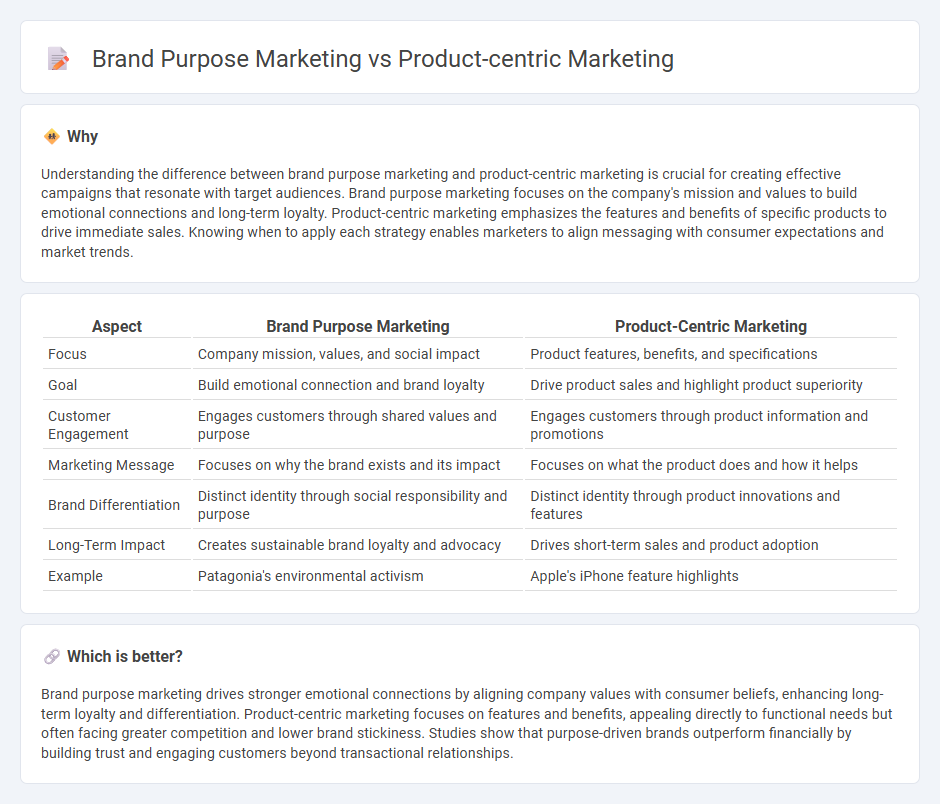
Brand purpose marketing emphasizes a company's values and mission to connect emotionally with customers, fostering loyalty and long-term engagement. Product-centric marketing focuses primarily on the features, benefits, and quality of the product itself to drive sales and differentiate from competitors. Explore the unique advantages of both strategies to enhance your marketing effectiveness.
Why it is important
Understanding the difference between brand purpose marketing and product-centric marketing is crucial for creating effective campaigns that resonate with target audiences. Brand purpose marketing focuses on the company's mission and values to build emotional connections and long-term loyalty. Product-centric marketing emphasizes the features and benefits of specific products to drive immediate sales. Knowing when to apply each strategy enables marketers to align messaging with consumer expectations and market trends.
Comparison Table
| Aspect | Brand Purpose Marketing | Product-Centric Marketing |
|---|---|---|
| Focus | Company mission, values, and social impact | Product features, benefits, and specifications |
| Goal | Build emotional connection and brand loyalty | Drive product sales and highlight product superiority |
| Customer Engagement | Engages customers through shared values and purpose | Engages customers through product information and promotions |
| Marketing Message | Focuses on why the brand exists and its impact | Focuses on what the product does and how it helps |
| Brand Differentiation | Distinct identity through social responsibility and purpose | Distinct identity through product innovations and features |
| Long-Term Impact | Creates sustainable brand loyalty and advocacy | Drives short-term sales and product adoption |
| Example | Patagonia's environmental activism | Apple's iPhone feature highlights |
Which is better?
Brand purpose marketing drives stronger emotional connections by aligning company values with consumer beliefs, enhancing long-term loyalty and differentiation. Product-centric marketing focuses on features and benefits, appealing directly to functional needs but often facing greater competition and lower brand stickiness. Studies show that purpose-driven brands outperform financially by building trust and engaging customers beyond transactional relationships.
Connection
Brand purpose marketing and product-centric marketing connect by aligning a company's core values with the features and benefits of its products, creating a cohesive customer experience. Emphasizing authentic brand purpose enhances product appeal, driving consumer trust and long-term loyalty. Integrating these strategies optimizes market positioning and strengthens overall brand equity.
Key Terms
Features & Benefits
Product-centric marketing emphasizes features and benefits that directly address customer needs, highlighting tangible attributes like performance, price, and usability. Brand purpose marketing connects these features to a deeper mission or value, fostering emotional engagement and loyalty by aligning with consumers' beliefs. Explore how integrating both strategies can maximize customer appeal and brand impact.
Emotional Connection
Product-centric marketing emphasizes the features, benefits, and specifications of a product to attract customers, often targeting rational decision-making processes. Brand purpose marketing centers on the emotional connection by aligning the brand with values, missions, and social causes that resonate deeply with consumers. Discover how integrating emotional storytelling can transform your marketing strategy and build lasting customer loyalty.
Differentiation
Product-centric marketing emphasizes unique features and functional benefits to differentiate offerings in competitive markets, leveraging tangible attributes such as quality, innovation, or performance. Brand purpose marketing drives differentiation by connecting with customers on emotional and ethical levels, highlighting values, social impact, and long-term vision to create loyalty and advocacy. Explore how combining both strategies can maximize differentiation and deepen consumer engagement.
Source and External Links
How to Combine Product and Customer-Centricity - Product-centric marketing is focused on selling products based on their features and attributes, such as a fridge being marketed for its "extra-large" size or "ice-maker," while contrasting with customer-centric marketing that emphasizes product benefits tailored to customer needs; this approach is seen as more traditional and is evolving toward combining product and customer-centricity for relevance in data-driven markets.
Product-Centric vs. Customer-Centric: Which Wins? - Product-centric marketing relies on a strong internal vision and technical expertise, emphasizing innovation and long product development cycles, where companies create demand through advanced features and bold product releases rather than responding immediately to customer demands.
Product Centric: Definition, Examples, and Applications - A product-centric approach places the product or service at the center of all business decisions, believing that delivering superior products naturally attracts customers and drives growth, differing from customer-centric approaches which focus more on understanding and meeting customer needs.
 dowidth.com
dowidth.com